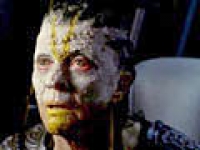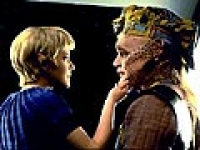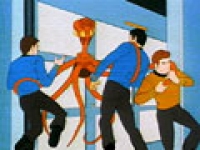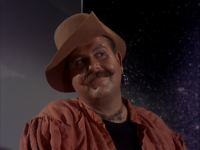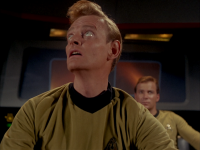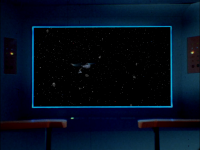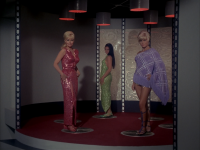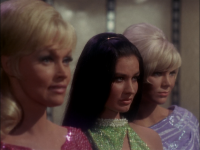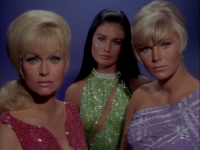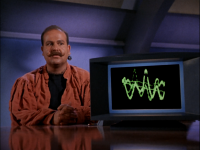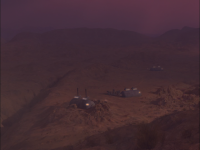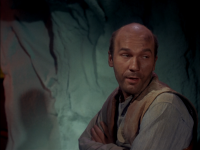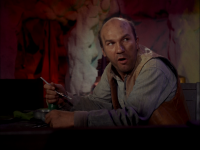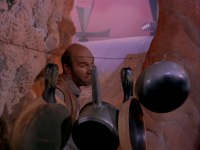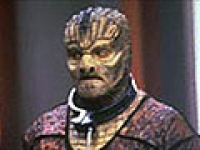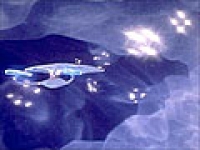Star Trek: Newest — 1x06 — Terminal Provocations
Synopsis
The lovable, but awkward, Ensign Fletcher makes work difficult for Mariner and Boimler. Rutherford introduces Tendi to a holodeck training program he created.
Remarkable scenes
- T'Anna: "Do you know how hard it is to get cheese out of fur in a sonic shower?!"
- Tendi fallling for Badgy.
- Badgy going on a rampage.
- Fletcher getting promoted and transferred to the Titan only to be fired shortly thereafter.
Review
It was inevitable for this show to do a holodeck malfunction episode and they didn't disappoint! Badgy was hilarious and stole the show. The Fletcher main plot was unfortunately much less effective, as he was mostly just annoying the whole way through rather than funny. His best scene was bumbling into a promotion and a transfer to the Titan only be fired days later. But hot off the heels of the last episode's DS9 cameo, this was definitely a missed opportunity for a meatier cameo once again. This show needs to commit to its cameos more! If you're gonna have Fletcher get transferred to the Titan, then show a cameo of Captain Riker firing Fletcher! If you're gonna show a bar scene at Deep Space Nine, make it Quark's bar instead of the Quito's! Show Quark or other DS9 characters in the background or something. You don't even need to give them lines. With an animated medium, it should be trivial and largely costless to flesh out these cameos more.
The most unfortunate detail in the episode though was Shaxs' preoccupation with murdering the Drookmani, repeatedly asking for permission to fire on their warp core, which would've destroyed the entire ship. It's well-established on Star Trek by now that there are plenty of less than lethal methods of disabling a hostile opponent in battle. It doesn't always work, but it's at least worth trying. Apparently even Captain Freeman forgot this when she eventually broke down and ordered Shaxs to fire on their warp core. And the only reason it didn't work was because of a computer glitch. That scene did much to undermine both of their characters and ran quite counter to the spirit of Star Trek. It was perhaps the most dispiriting scene in all of Lower Decks so far. Sure, people might defend it by claiming it was just a joke, but it's important to remember this show is canon, not a parody, and murder is not funny. That scene was the closest thing this show has gotten to the atrocious Discovery short "The Trouble With Edward" so far, and let's hope that's as close as they ever get.
By and large though, this was a pretty entertaining episode. With fewer flaws, better use of cameos, and more focus on effective comedy ideas like Badgy, it would've been worth considerably more points.
Star Trek: Newest — 1x06 — The Impossible Box
Synopsis
Picard and the crew track Soji to the Borg cube in Romulan space, resurfacing haunting memories for Picard. Meanwhile, Narek believes he finally found a way to safely exploit Soji for information.
Remarkable scenes
- Raffi sweet talking Captain Bosch into letting them visit the artifact.
- Rios to Raffi: "No one gets all of it right."
- Soji scanning all of her childhood memorabilia and reacting with horror as the tricorder consistently responds that all of it is 37 months old.
- Picard's panic attack while visiting the Borg cube.
- Picard to Hugh: "You're showing what the Borg are underneath. They're victims, not monsters."
- Hugh regarding the xBs on the artifact: "Just as helpless and enslaved as before. Only now our queen is a Romulan."
- Narek betraying Soji.
- Hugh beaming Picard and Soji light years away using Borg technology while Elnor beams to the cube to defend Picard. Elnor: "Please my friends, choose to live."
Review
An episode with a slow start but a good amount of payoff. Hugh and Picard catching up with each other is the clear highlight of the episode, a reunion that was literally decades in the making both on screen and off screen after the ambiguous way they left things in TNG: Descent, Part 2. It's nice to hear that despite Hugh being from an unknown species, he was able to acquire Federation citizenship anyway after his misadventures with Lore. Picard's panic attack upon returning to a Borg cube was entirely appropriate and compellingly portrayed. We see all sorts of classic scenes in his post-traumatic stress flashback, including iconic scenes from TNG: The Best of Both Worlds and Star Trek VIII: First Contact. It was also a nice touch to see Hugh directly contrasted from his appearance on TNG to his appearance now visually on Picard's computer.
The ultimate message of Picard's reunion with Hugh was to portray the Borg more as victims than as villains. This is deeply in the spirit of Star Trek and one of the most fascinating contradictions that has always been at the core of the characterization of the Borg. Are they an enemy to be destroyed, or victims to be rescued? If xBs should not be held accountable for the crimes they committed as Borg, then who should? One might be tempted to say the Borg queen, but even she has never seemed to be a character with terribly much agency. More like a reflection of the Borg's collective consciousness given that whenever she's destroyed another appears. These are questions without obvious answers and Star Trek is at its best when it grapples with them as they do in this episode.
Another highlight of the episode is the terrific execution of Soji's dream sequences. The two actors playing child Soji (Ella McKenzie) and adult Soji (Isa Briones) do a great job of convincingly portraying the same person in the same emotional state across the cuts. This may seem like a minor detail, but it's very easy to get wrong. Star Trek in particular is infamous for numerous previous examples of child character performances that fall flat. Even high budget drama series get it wrong frequently too, such as the underwhelming portrayal of young Ned Stark on Game of Thrones. A particularly nice touch in Soji's dream was the abstract presentation of her construction being doll-like. This distinctly resembled Pinocchio; Data had been previously referred to as being like Pinocchio by Riker in TNG because of his desire to become human.
One more interesting reference to a previous Star Trek episode was when Hugh dug up a Sikarian spatial trajector to help Picard and Soji escape the cube. This technology was last seen in Voy: Prime Factors when the crew of Voyager was denied the use of it to help them get home faster by the Sikarian equivalent of the Prime Directive. It appears the Borg assimilated the Sikarians at some point After Voyager's visit, after which they improved upon the technology, removing the dependency on a planet with a thick tetrahedral quartz mantle to function. It was said the Borg only use this technology in the case of emergencies, but the reason for such a restriction is not clearly explained. The trajector is in effect a very long range transporter which if deployed en masse could be a very powerful weapon.
If the Romulans were to get their hands on it they could in theory use it to beam an invasion force across the galaxy in an instant, not unlike the fears that were stoked by the Iconian gateways in TNG: Contagion and DS9: To the Death. Indeed, whenever a technology this powerful is discovered on Star Trek, it tends to be quickly destroyed, concealed, or some fatal flaw is discovered in it so as to prevent the canon from being contaminated with too many superpowers. Hugh made attempts to conceal this technology from the Romulans, but hopefully some stricter limits are placed on it soon or it might risk becoming as ridiculous as something like Discovery's spore drive. The last thing we need is more ways for groups of people or starships to instantly teleport across the galaxy.
Star Trek: Newest — 1x06 — Lethe
Synopsis
The U.S.S. Discovery crew is intrigued by new addition, Lt. Ash Tyler. Sarek seeks Burnham's help, rekindling memories from her past. Admiral Cornwell questions Lorca's tactics.
Remarkable scenes
- That gorgeous shot of a Vulcan city.
- The Vulcan extremist blowing himself up in an attempt to kill Sarek. Interesting that the technology closely resembled Ent: Chosen Realm.
- Burnham's flashback to her past via Sarek's memory.
- Lorca defying orders to stage a rescue of Sarek.
- Cornwell: "You launched an unauthorized rescue mission using a convicted mutineer! Not to mention a POW who has barely had time to recover! Can you even trust this guy?"
- Lorca freaking out at Cornwell and pulling a phaser on her out of nowhere when she touched his scar.
- Lorca: "Don't take my ship away from me! She's all I got. Please, I'm begging you."
Review
A straightforward, but touching story. The attack on Sarek and his rescue is dramatically compelling, the deeper window into Burnham's backstory with Sarek is intriguing, and the insight into Sarek's conduct as a father not just of Burnham but of Spock also is fascinating. It's nice to see that Vulcans aren't exactly a totally unified society after the events of Enterprise. It always made sense that the nativism the Romulans exploited would've originated as a homegrown phenomenon that the Romulans merely fanned the flames of, rather than something they conjured up from whole cloth. A demagogue can't succeed without some demand for demagoguery. Even a hundred years after the demagogic (for a Vulcan) leader and secret Romulan collaborator V'Las was removed from power in disgrace, those nativist feelings are still simmering on Vulcan. There is still a group which sees humans as inferior, and even views the Federation as a failed experiment. This sentiment apparently extended far enough to deny Burnham a job in the Vulcan Expeditionary Group based entirely and explicitly on race rather than merit. This resentment of outsiders was so intense that it was the reason for the bombing of the Vulcan Learning Center. Burnham was the target of the terrorist attack; the extremists were trying to assassinate her.
Meanwhile, the nature of Lorca's psych issues becomes a bit clearer here in a quite creepy way. Cornwell stages a much needed intervention on Lorca, whose erratic behavior should rightly be a cause of concern for Starfleet. After psychoanalyzing him, she concludes that his behavior is pathological and manipulative. During a particularly chilling scene, she admits that she can't tell whether or not Lorca is being emotionally honest with her or just pretending to feel the things she expects him to feel. And in one of the most chilling scenes yet aired, Lorca jumps at the chance to manipulate Cornwell into taking Sarek's place for the meeting with the Klingons, almost as though he knew she would be captured. Did he know somehow? Or was he just trying to get her off the ship temporarily while he figured out what to do? Or worse yet, did he tip off the Klingons somehow? All to keep Cornwell off his back? These are disturbing things to ponder. Regardless, he is certainly taking advantage of her absence, given that he is now all too willing to drag his feet rescuing her by uncharacteristically (as Saru explicitly makes note of) going through proper (slow) channels to get a rescue mission authorized. Clearly Lorca is in no hurry to see Cornwell again, a person that is supposed to be his friend. Like Harry Mudd, Cornwell is left at the mercy of the Klingons because Lorca is apparently a sociopath. Given all that, Burnham's line, "I'm grateful to serve under a captain like you." was a pretty nice piece of irony.
While this episode is overall quite good, there are a few wrinkles in the story. Despite Cornwell's concerns about him, Ash Tyler seems to be coping far too well with his ex-POW status. Aside from his overwhelmingly contrived interruption of Burnham's attempt to reach Sarek seemingly for no other reason than to dispense seasoned veteran advice about how people going through near death experiences dwell on what they wish they would've done differently, Tyler was a picture of good character and perfect conduct, which is not something one generally expects from someone who just spent the better part of a year being tortured. Perhaps the most annoying feature of the episode though was seeing them using the spore drive with impunity now, seemingly without additional costs. At least no costs other than Stamets acting weird again and being oddly cheerful in a creepy way. It's like the annoying cliffhanger from the last episode never happened. This episode doesn't deal with the consequences of having Stamets pilot the spore drive at all, which is a pretty big dramatic oversight. Although Cornwell's remark that Starfleet knows about Stamets' illegal eugenics work is delightfully ominous. As we know from other Star Trek shows, augments are rarely treated well.
Also of note, it is pretty neat to see Kol dolling out cloaking technology in exchange for loyalty oaths. Using new technology as leverage to dominate the other great houses feels very authentically Klingon and it adds a nice piece of texture to Klingon history.
Star Trek: Newest — 1x06 — Terra Nova
Synopsis
Archer and the Enterprise crew set out to learn what happened to the lost human colony of Terra Nova, and discover a tribe of human-hating cave dwellers.
Remarkable scenes
- Archer showing Nadet who she is with old photographs.
- Archer and T'Pol arguing about what to do about the colonists.
- The shuttlepod sinking into the ground on Terra Nova.
Review
A real mixed bag. It was a good idea to show details regarding Earth's early extrasolar colonies, but they couldn't have done it in a worse way. This whole episode is more or less a rehash of Voy: Friendship One. And indeed smaller plot elements in this episode resemble numerous other episodes. Suffice it to say, this plot is hardly original. But at least it's appropriate. Unfortunately, the already weak plot strains the hell out of credibility. For one, there's the Alpha Centauri technical problem, which is documented in the problems section. Suffice it to say, Alpha Centauri would have made much more sense as a setting for Earth's first extrasolar colony. Then there's the timing. Also documented in the problems section, this episode contradicts Voy: The 37s regarding when Mars was colonized. All of the technical problems could have easily been avoided by simply not making Terra Nova Earth's first extrasolar colony and giving specific dates, but by making it one of many of Earth's first extrasolar colonies. In this respect, the plot could be viewed exactly the same way as intended, except in a more credible manner. There were a few details to redeem the episode, though. One thing I liked was that the Novans had a unique vocabulary, using strange terms much like the Vori from Voy: Nemesis. I was also quite fond of how patient Archer and his crew were with the rather uninformed Novans. I also liked T'Pol's objective opinion once again. Unfortunately, these details do little to enhance this rather ill conceived episode.
Star Trek: Newest — 1x06 — The Cloud
Synopsis
Voyager encounters a living nebula.
Remarkable scenes
- Janeway's opening log entry.
- Janeway: "There's coffee in that nebula!"
- Neelix criticizing Janeway's exploratory nature.
- The Doctor's appearance, startling Torres. I like how the Doctor bemoans about never being summoned for an important reason.
- The Doctor: "A nebula? What were we doing in a nebula? No wait, don't tell me. We were 'investigating.' That's all we do around here. Why pretend we're going home at all, all we're going to do is 'investigate' every cubic millimeter of this quadrant, aren't we?"
- Janeway's vision quest.
- Torres tried to kill her animal guide. Why does that not surprise me? :)
- Janeway muting the doctor and the doctor waving his hands across the viewscreen later to get attention. Hilarious!
- Janeway's handling of Neelix' objections.
- Voyager behind tossed about by the nebula creature.
- The Doctor's suture suggestion.
- Paris' holodeck characters offending the women.
Review
This episode has a particular charm to it. There are many little details which illustrate how the crew is (or isn't) adapting to their new journey, and despite being low on resources, the episode is true to the spirit of Star Trek, for they have accidentally injured a space born alien and now they must do their moral duty and repair it. Beyond this there's not much particularly interesting about the episode, we've seen space born creatures before, though perhaps not as large, and perhaps not as well rendered in the VFX department, from strictly a conceptual standpoint the episode offers very little new material. A decent offering though.
Star Trek: Newest — 1x06 — The Survivor
Synopsis
A long-lost philanthropist, Carter Winston, is discovered on board a damaged one-man vessel and is reunited with his fiancee on board the Enterprise.
Remarkable scenes
- Romulan: "You appear to have a propensity for trespassing in the neutral zone, captain Kirk." Kirk: "It was not deliberate, I assure you." Romulan: "It never is." A nice reference to all the times the Enterprise has crossed the zone.
Review
I couldn't write a better review than the one of pure perfection on Bernd Schneider's site. "A living legend of the Federation (what a surprise) on a damaged shuttle (what a surprise), whose fiancee is on the Enterprise (what a surprise), turns out a shapeshifter (what a surprise), causes trouble by assuming the shapes of crew members (what a surprise) and orders a course through the Neutral Zone (what a surprise). The whole episode is nothing but 'All kinds of TOS cliches in 25 minutes', almost like an unintentional parody, and doesn't show anything original." I might add, another alien race which we'll never see again (what a surprise) and another female crewmember who fails in her duty thanks to love (what a surprise).
Star Trek: Newest — 1x06 — Mudd's Women
Synopsis
The Enterprise rescues con artist Harry Mudd and his "beautiful" female cargo.
Filler rating: bad filler
Technically Mudd will recur, but all episodes which feature him suck, so they can all be considered bad filler.
Remarkable scenes
- Mudd: "You'll find out that ships' captains are already married, girl, to their vessels. You'd find that out the first time you came between him and the ship."
- Mudd's customers fighting over the women.
Review
Mudd's Women does much to assault the credibility of Star Trek's progressive future which was supposed depict, among other things, a world without sexism. It makes sense that even in the universe of Star Trek that there are groups of people or cultural idiosyncrasies that constitute a throwback, but the way that the plot of this episode treats the whole thing as if it were normative and widespread is offensive.
What's worse is even setting that aside, this episode's plot logic doesn't make much sense. If Mudd's magic pills were placebos, then why did the appearances of the women so dramatically change after taking them? And why didn't any of the security personnel assigned to monitor Mudd report any of the numerous things they overheard to the captain? Add to that Mudd's acting. The less said about it the better. This is easily the worst episode so far.
Star Trek: Newest — 1x06 — Captive Pursuit
Synopsis
Through a new friendship with a bizarre alien, O'Brien and the rest of the officers of Deep Space Nine learn that other beings do not respect life as much as they do.
Filler rating: good filler
There's no essential plot or exposition in this episode that renders it unskippable, but it's a decent episode, even though it could have been better.
Remarkable scenes
- Sisko discussing Miss Sadra's grievance with her.
- Tosk's funny accent and behavior.
- Odo refusing to use a phaser.
- Tosk to Quark: "I live the greatest adventure one could ever desire."
- The hunter's opening lines belittling Tosk.
- Tosk to O'Brien: "I am Tosk. The hunted. I live to outwit the hunters for another day. To survive until I die with honor."
- Quark to O'Brien: "More trouble with the little woman?" A reference to DS9: A Man Alone when Quark overheard his conversation with Keiko.
- O'Brien regarding the hunter: "Glass jaw. Now I know why you wear a helment."
- Sisko "officially" chastising O'Brien for his conduct, but secretly admiring him.
- Morn appearances; 1. Quark's Bar as O'Brien and Tosk stop at the entrance; 2. Quark's Bar, can be seen in the background with his back to the camera when Quark tries to cheer up O'Brien.
Review
Our first look at life on the other side of the wormhole depicts a xenophobic and arrogant gamma quadrant. Some highlights: Odo's handling of Tosk's minor crime aboard the station was great. Odo isn't always the "ill tempered old crosspatch" Quark would have us believe. More interesting is O'Brien's role in the story. First O'Brien makes friends with Tosk, then he tries stick up for Tosk to Sisko, then he feels responsible for him, then he helps him escape. Notable as well is Sisko's subtle hint to O'Brien that he completely respects the judgment call he made, even though he officially chewed him out. Finally, Tosk himself was a great character who was played wonderfully by the actor. The accent was especially pleasing.
Star Trek: Newest — 1x06 — Where No One Has Gone Before
Synopsis
The crew is sent a billion light years from their own galaxy.
Filler rating: not filler
This episode is essential viewing for Wesley's character development.
Remarkable scenes
- Kosinski's incredibly obnoxious behavior.
- Picard walking out into space from the turbolift.
Review
While this is yet another not-so-subtle nod to a TOS episode—this time to TOS: Where No Man Has Gone Before—this time the rehash is far superior to the original. Even the title reflects careful refinement: replacing the word "man" with "one" in the title of the episode (just as was done in the opening theme of TNG versus TOS) is an explicit rebuke of the accidental(?) sexism of TOS' popular catchphrase "where no man has gone before."
In the original take on the story, Gary Mitchell embodied both Kosinski's obnoxiousness and the Traveler's superpowers in a single person. Separating these two qualities into two different characters and misleading the characters into thinking Kosinski had real talent only to be outed by Wesley was a nice touch. The foreshadowing about Wesley possibly having the potential to develop the Traveler's superpowers himself some day is also an intriguing piece of character development for him; as was Picard deciding to make him an acting ensign and encouraging him to go to the academy.
The metaphysical stuff about thought becoming reality at the edge of the universe worked considerably less well. Star Trek is not exactly at its best when it delves into this new-agey quasi-religious mumbo jumbo as a plot device. And once again we have yet another non-corporeal somewhat godlike alien. All things considered though, this is the best episode since Encounter at Farpoint.



